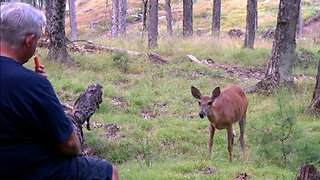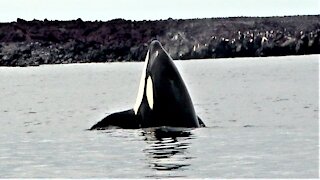Premium Only Content

Nature can be cruel in heartbreaking struggle for survival
We think of nature as being beautiful, awe inspiring, and even benevolent most of the time. We are in wonder at the sight of a colorful sunset or a magnificent creature. The way the intricate web of life works and the tiny details that are required to keep entire ecosystems running smoothly leaves us with the sense that everything has been carefully and precisely engineered. But occasionally, nature provides us with a glimpse of just how cruel and heartless it can also be.
Many creatures are prey and many are predators, but the balance is delicate and the tables can turn in an instant, making the predator the lower creature on the food chain. Survival adaptations and specialized skills can mean that size isn't the only factor in a battle between two beasts.
This common toad is a perfect example of being both predator and prey at the same time. It had been hopping along the forest floor near a cottage in Parry Sound, Ontario, gobbling up ants and tiny creatures in great numbers. Cottagers on this remote island had seen the toad on the path to the beach and they remarked on how big and colorful he was. They watched briefly as he hunted for food among the twigs and pine needles. But later that same day, one of them heard a commotion and went to see what was happening. Following the rustling in the leaves, he saw the same large toad in a very unfortunate predicament. A long garter snake had seized the hind leg of the toad and was trying to eat it. Being a true nature lover, the cottager's sympathies were with the toad and he desperately wanted to help. But interfering with nature means that somebody doesn't eat and possibly doesn't survive so he respected the situation and left it to play out as it would.
As harsh as it sometimes is, nature is also very fascinating. It first appeared that the toad was impossibly large and that the snake could not swallow it. Easily three or four times the diameter of the snake's mouth, the toad would not ordinarily fit. But the snake has evolved with a jaw that can be unhinged so that its mouth can be stretched to several times its normal size. Using small, but sharp teeth, the snake held the toad while slowly working its mouth forward and around it. Venom secreted in the saliva of the snake helped to slowly immobilize the toad as the venom worked its way in through wounds inflicted in the battle.
The toad tried to inflate its body, somehow understanding the need to make itself too large to eat. The two animals clawed and wrestled for more than 5 hours until the toad succumbed to the venom and the pressure around it. With the toad almost fully in its mouth, the snake retreated to the underbrush to finish the job. Snakes are cold blooded and require the warmth of the sun for movement and digestion. Most of this battle took place in the sunlight, but as night approached, the snake knew that shelter was its best option. It was seen the next day, sunning itself near the shore to keep its body temperature high to absorb the toad.
While the snake was the top predator in this struggle, it was also vulnerable the whole time to hawks, foxes, or other animals. Escape from a predator would be nearly impossible when the snake was trying to eat the toad. We are fortunate that we humans do not often have the same daily risks and struggles as almost all other creatures on the planet. For them, life is precarious from start to finish.
-
 1:57
1:57
WildCreatures
1 month ago $7.17 earnedCurious wild deer comes to share a snack with man in forest
47.8K15 -
 1:11
1:11
WildCreatures
3 years ago $383.58 earnedBattle for survival between orca and gigantic Pacific sea turtle
13.6K23 -
 LIVE
LIVE
Game On!
14 hours agoTom Brady And The Las Vegas Raiders ARE BACK! 2025 NFL Preview!
7,618 watching -
 LIVE
LIVE
The Bubba Army
2 days agoShould RaJa Jackson Be Arrested? - Bubba the Love Sponge® Show | 8/25/25
3,280 watching -
 LIVE
LIVE
FyrBorne
13 hours ago🔴Warzone M&K Sniping: Builds So Strong They Think I'm Hacking
551 watching -
 LIVE
LIVE
BEK TV
2 days agoTrent Loos in the Morning - 8/25/2025
1,790 watching -
 4:23
4:23
Blackstone Griddles
15 hours agoEasy Salmon Dinner on the Blackstone Griddle
27.3K1 -
 8:10
8:10
WhaddoYouMeme
1 day ago $0.06 earnedChristians, Before You See “Testament”, Watch this!
7.36K4 -
 8:42
8:42
Freedom Frontline
14 hours agoDurbin’s Trump Smear Video Just HUMILIATED Him in the Senate
9.21K4 -
 10:56
10:56
ariellescarcella
12 hours agoThe Shocking Divide Among College Voters Sparks Worry For America
7.57K6